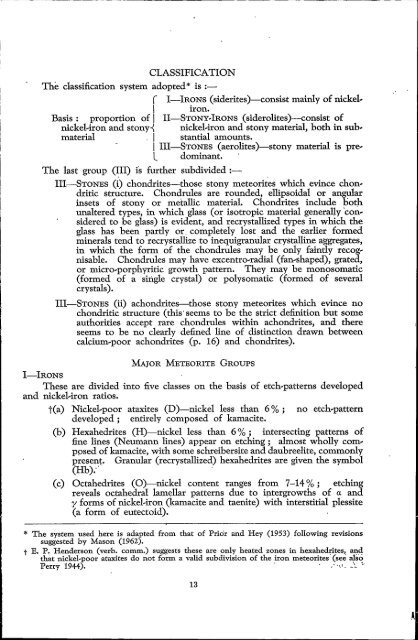catalogue of western australian meteorite collections
catalogue of western australian meteorite collections
catalogue of western australian meteorite collections
You also want an ePaper? Increase the reach of your titles
YUMPU automatically turns print PDFs into web optimized ePapers that Google loves.
------- ~ -------------------------------------<br />
CLASSIFICATION<br />
The classification system adopted* is :-<br />
rI-IRONS (siderites)-consist mainly <strong>of</strong> nickel~<br />
iron.<br />
Basis: proportion <strong>of</strong> I II-STONy-IRONS (siderolites)-consist <strong>of</strong><br />
nickel-iron and stony~ nickel-iron and stony material, both in sub~<br />
material I stantial amounts.<br />
I Ill-STONES (aerolites)-stony material is pre~<br />
l dominant.<br />
The last group (111)<br />
.<br />
is further subdivided:-<br />
.<br />
Ill-STONES (i) chondrites-those stony <strong>meteorite</strong>s which evince chon~<br />
dritic structure. Chondrules are rounded, ellipsoidal or angular<br />
insets <strong>of</strong> stony or metallic material. Chondrites include botJJ.<br />
unaltered types, in which glass (or isotropic material generalJy 'con~<br />
sidered to be glass) is evident, and recrystallized types in which the<br />
glass has been partly or. completely lost and the earlier formed<br />
minerals tend to recrystallize to inequigranular crystalline aggregates,<br />
in which the form <strong>of</strong> the chondrules may be only faintly recog~<br />
nisable. Chondrules may have excentro-radial (fan-shaped), grated,<br />
or r:nicro-porphyritic growth pattern. They may be monosomatic<br />
(formed <strong>of</strong> a single crystal) or polysomatic (formed <strong>of</strong> several<br />
crystals).<br />
Ill-STONES (ii) achondrites-those stony <strong>meteorite</strong>s which evince no<br />
chondritic structure (this' seems to be the strict definition but some<br />
authorities accept rare chondrules within achondrites, and there<br />
seems to be no clearly defined line <strong>of</strong> distinction drawn between<br />
calcium-poor achondrites (p. 16) and chondrites).<br />
MAJOR METEORITE GROUPS<br />
I-IRONS<br />
These are divided into five classes on the basis <strong>of</strong> etch-patterns developed<br />
and nickel-iron ratios.<br />
tea) Nickel-poor ataxites (D)-nickel less than 6 %; no etch~pattern<br />
developed; entirely composed <strong>of</strong> kamacite.<br />
(b) Hexahedrites (H)-nickel less than 6 %; intersecting patterns <strong>of</strong><br />
fine lines (Neumann lines) appear on etching; almost wholly com~<br />
ppsed <strong>of</strong> kamacite, with some schreibersite and daubreelite, commonly<br />
present. Granular (recrystallized) hexahedrites are given the symbol<br />
(Hb);'<br />
(c) Octahedrites (O)-nickel content ranges from 7-14 % ; etching<br />
reveals octahedral lam~llar patterns due to ip.tergrowths <strong>of</strong> a and<br />
y forms <strong>of</strong> nickel-iron (kamacite and taenite) with interstitial pIessite<br />
(a form <strong>of</strong> eutectoid).<br />
* The system used here is adapted from that <strong>of</strong> Prior and Hey (1953) following revisions<br />
suggested by Mason (1962).<br />
t E. P. Henderson (verb. comm.) suggests these are only heated zones in hexahedrites" an4<br />
that nickel-poor ataxites do not form a valid subdivision <strong>of</strong> the iron <strong>meteorite</strong>s (see also<br />
Perry 1944). . , .' ".' - .-". ,.<br />
13
















